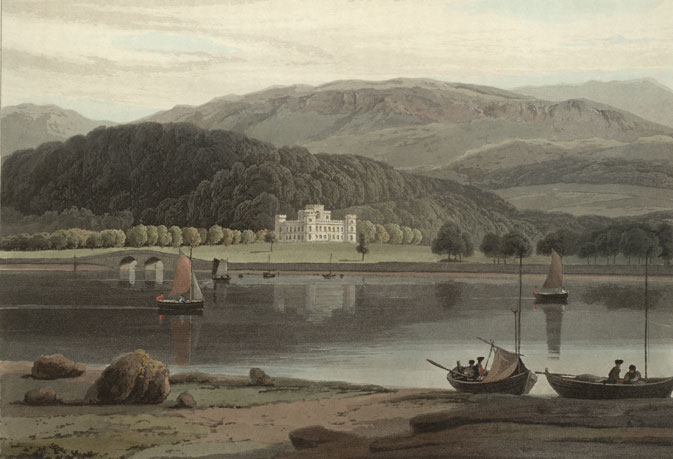DANIELL, William (1769-1837)
Inverary Castle, Argylshire

© National Library of Scotland.
William Daniell image supplied by the National Library of Scotland for use in the LEMA Project.
[Plate 24]
Inverary Castle
"...the next excursion was a most delightful ride of six hours over the mountains to Inverary, situated on a small bay at the head of Loch Fyne, at the mouth of the river Aray. The scenery for the greater part of the way was grand and striking, and the approach to that town, through a country abounding in full grown 'wood, was uncommonly fine. The most attractive feature in the prospect is INVERARY CASTLE, the principal seat or the Duke of Argyle, on the western side of the loch, of which a view is here given. It stands on a gentle slope in a spacious and noble park, bounded on one side by an amphitheatre of well wooded hills, and on the other by Loch Fyne, which, expanding in front of the mansion, forms an irregular circle about twelve miles in circumference, beautifully indented by small promontories, and backed by a grand range of highland scenery. The castle is a modern edifice. Its principal hall is a spacious apartment surrounded by a gallery, in which there is an organ. Here are suspended arms and other characteristics of a Highland castle. Among the other apartments the large drawing-room is particularly lady worthy of notice, as containing some of the finest specimens of the Gobelin tapestry in this kingdom. Among the portraits is a head of the celebrated Earl of Argyle, who was put to death in the reign of James II. for having favoured the unsuccessful attempt of the Duke of Monmouth, and whose magnanimity is so well described in the historical fragment of Mr. Fox. It ought to be mentioned, that the plantations which now adorn this seat originated chiefly with him, or at least that he set the example of that good taste which his successors have so spiritedly followed. Since the year 1745, when the present edifice was founded, it is calculated that £250,000 have been expended in plantation and other works of utility and decoration on this property, and that the late duke laid out at least three thousand pounds per annum in similar improvements. In so flourishing a state are the woods and plantations at present, that the thinning of them produces at least £1500 annually. From this fact may be calculated the great benefits which Scotland will one day derive from the extensive plantations with which various parts of her territory have since been covered.
The present town of Inverary is small, consisting chiefly of one row of houses facing the loch; they are well built and of uniform structure. The old town situated on the north side of the bay, on the lawn before the castle, being an irregular straggling village, was raised when the site of the present one was chosen. Inverary was erected into a royal burgh by a charter from Charles the First, dated at Carisbrooke Castle in the Isle of Wight, 28th January, 1648. A provost, two bail lies, and a Council, nominated by the Duke of Argyle, who is the proprietor of the whole town, govern it. Though tolerably well situated for manufactures, none of any great extent is carried on here. About the year 1748 the linen manufacture was introduced into the neighbourhood by Archibald, Duke of Argyle, with some success. A less fortunate attempt was made in 1766 to introduce the woollen manufacture, which, notwithstanding the public-spirited exertions and munificence of the then duke, seconded by many gentlemen of the county, did not flourish.
The great support of Inverary is the herring-fishery of Loch Fyne. It generally begins in July, and sometimes continues until the first of January. In the height of the season, according to the hyperbolical adage of the country, the loch contains one part of water and two parts of herrings. They are, and have been, from time immemorial, reputed the finest both in size and quality that Scotland produces. The extent of the loch, to its junction with the sea, exceeds thirty miles; and in the single bay of Inverary, at its inland extremity, 500 or 600 boats are sometimes employed in the fishery, and the groups of them with their circling nets form an interesting picture. The night is the time of fishing; in the day-time the crews take their rest, or employ themselves in extracting the entrails from the1ish they have taken, occasionally amusing themselves with singing Celtic ballads to the sound of the bag-pipe. Each boat dears on an average between £40 and £50 for the season, and in some very productive seasons £100, besides a supply a supply of fish reserved for domestic consumption. In an evening, when the fishing commences, a number of boats form a line across the loch, and uniting their nets, produce a chain often more than 100 fathoms long. The herrings swim at very uncertain depths, so that it is necessary to sink the nets to the depth which the shoal is known to take. Of course the success of the fishers must in a great measure depend upon their judgment or good fortune, in taking the proper depths; and it will frequently happen that the nets of one boat are fun of herrings, whilst those -of others scarcely take a single fish. They swim sometimes in twenty fathoms water, sometimes in fifty, and even at the bottom of the loch. The herrings, when cleared of the entrails, are thrown into a tub with a sprinkling of salt; they are then closely packed in barrels with alternate layers of salt, and after remaining in this state for a few weeks, they are repacked into other barrels for exportation. A considerable quantity, however, are sent fresh to Glasgow, Stirling, and other parts of the country."
Source: Extract from DANIELL, William. A Voyage Round Great Britain [1813-1823].
Back to Scotland: Gallery





